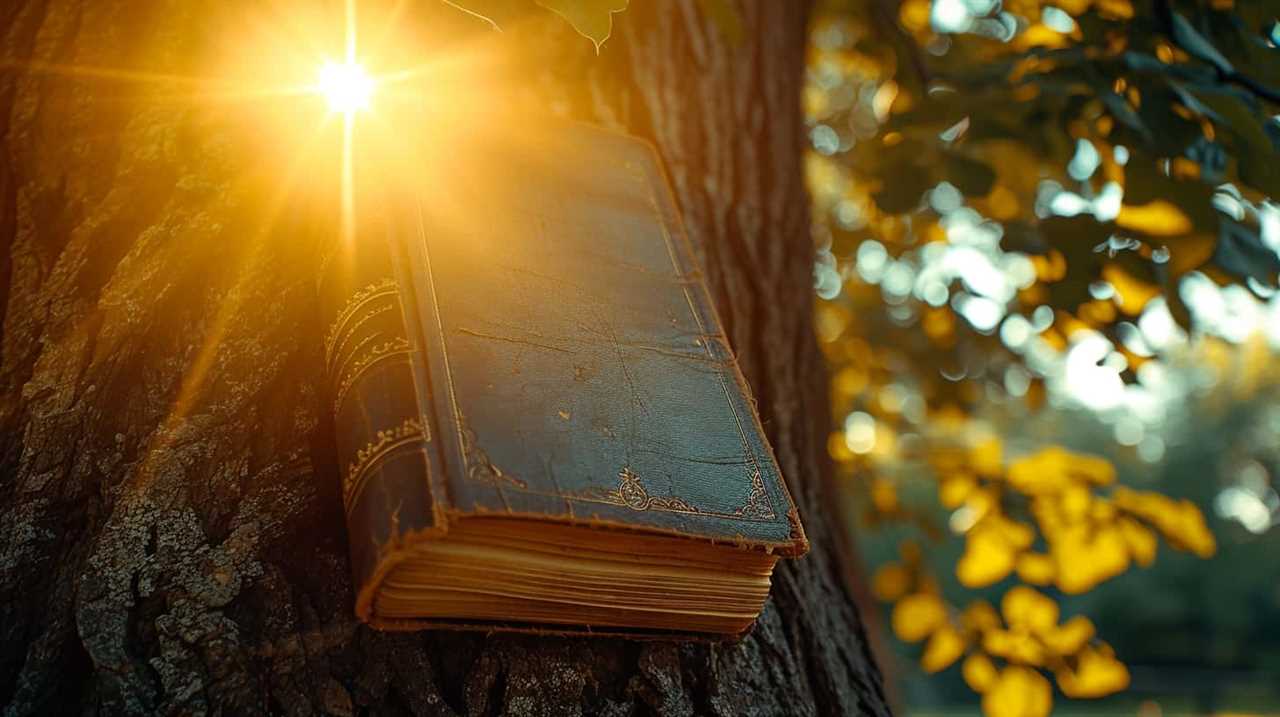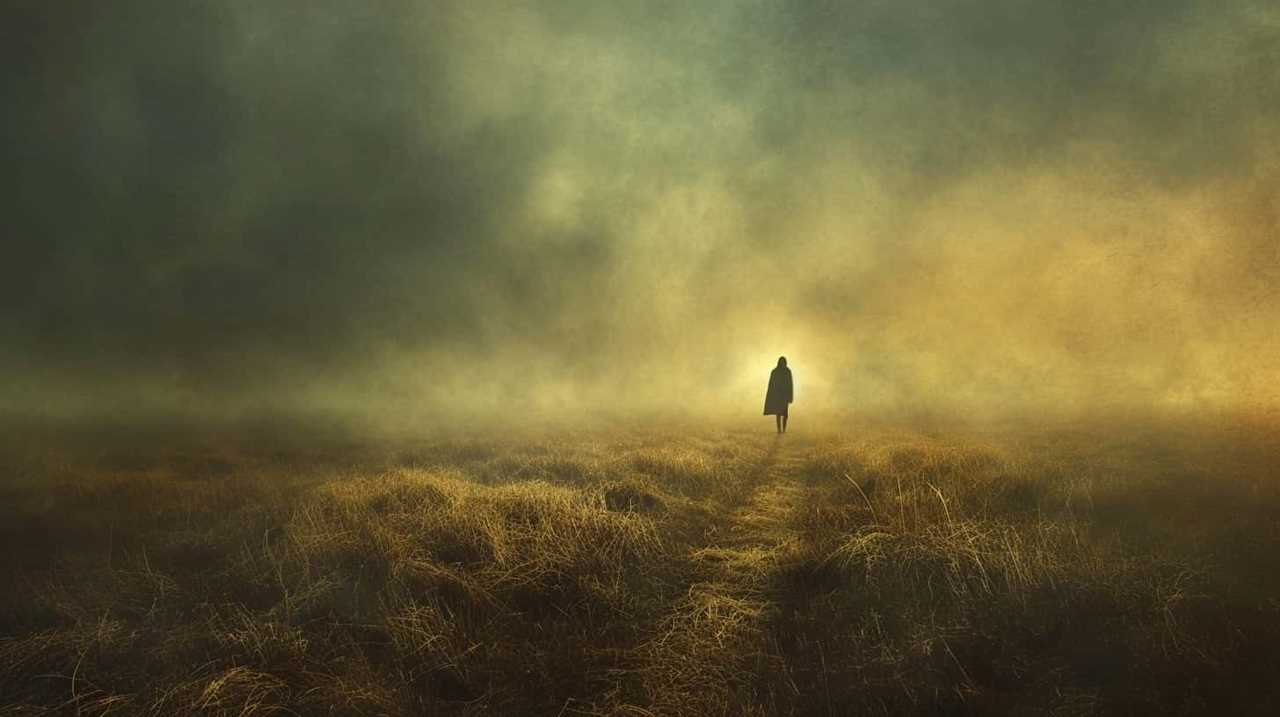Did you know that nature-inspired poetry is gaining popularity among creative minds? If you want to convey the essence of nature in your poetry, then you’re in the right place!
In this guide, we will explore seven tips that will help you infuse your poetry with the raw beauty and power of the natural world. From understanding the impact of nature imagery to embracing the tranquility it offers, these tips will ignite your creativity and take your poems to new heights.
So, get ready to immerse yourself in the wonders of nature and let its essence flow through your words. Let’s embark on this poetic journey together!
Key Takeaways
- Nature imagery evokes emotions and creates sensory experiences in poetry.
- Connecting emotions and nature in poetry allows for a powerful expression of the human experience.
- Symbolism in nature evokes powerful emotions and connections.
- Metaphors, personification, and synecdoche can be used to capture nature’s essence and uncover hidden meanings.
Understanding the Power of Nature Imagery
To truly grasp the impact of nature imagery in poetry, you must recognize its profound ability to evoke emotions and create vivid sensory experiences. Nature imagery has a unique power to transport readers to different landscapes, allowing them to feel a wide range of emotions. When poets weave nature into their verses, they tap into the reader’s innate connection with the natural world, stirring up feelings of awe, tranquility, and wonder. The use of descriptive language and vivid imagery enables readers to experience the sights, sounds, smells, and textures of the natural world, immersing themselves fully in the poet’s words.

The role of nature imagery in creating vivid and sensory poetry can’t be overstated. It adds depth and richness to the verses, making them come alive in the reader’s mind. Through carefully chosen words and metaphors, poets paint pictures that resonate with the audience, transporting them to breathtaking landscapes and inviting them to explore the beauty of the natural world. By engaging multiple senses, nature imagery creates a multi-dimensional experience that leaves a lasting impression on the reader.
As we delve into exploring the beauty of natural landscapes, we’ll further unravel the ways in which poets utilize nature imagery to capture its essence and evoke powerful emotions.
Exploring the Beauty of Natural Landscapes
As you immerse yourself in the world of poetry, let the beauty of natural landscapes captivate your senses and transport you to awe-inspiring realms. Exploring the serenity of natural waterfalls opens up a world of tranquility and wonder. The cascading waters, with their gentle flow or thunderous roar, evoke a sense of peace and harmony. The mist that rises from the cascades creates an ethereal atmosphere, inviting you to lose yourself in the magic of nature’s symphony.
Appreciating the grandeur of mountain landscapes is akin to encountering the divine. The towering peaks, reaching for the sky, command respect and admiration. Their majesty and strength remind us of our own insignificance in the face of nature’s power. The rugged terrain, adorned with lush greenery or a sprinkling of snow, invites exploration and adventure. Standing at the summit, you can gaze upon breathtaking vistas that stretch as far as the eye can see, filling your soul with a sense of awe and reverence.

These natural landscapes offer endless inspiration for poets seeking to capture the beauty of the world around them. Connecting emotions and nature in poetry allows for a deeper exploration of the human experience. Transitioning into the next section, let’s delve into the ways in which poets can infuse their verses with the essence of nature’s emotions.
Connecting Emotions and Nature in Poetry
Embrace the myriad of emotions that nature evokes in you as you craft your poetry. Connecting emotions and nature in haikus allows for a powerful and evocative expression of the human experience. Haikus, with their concise form and focus on capturing a single moment, are particularly suited to convey the intricate relationship between emotions and nature.
Nature has the remarkable ability to heal and soothe, which is why it holds such power in poetry. When you connect your emotions to the natural world in your poems, you create a profound connection between the internal and external landscapes. By intertwining the beauty of nature with the depths of your emotions, you invite readers to experience the healing power of nature through your words.
In your haikus, consider the specific ways in which nature resonates with your emotions. Perhaps a gentle breeze reflects a sense of peace or a stormy sky mirrors inner turmoil. By using vivid imagery and evocative language, you can immerse your readers in the emotional landscape you’re exploring.

Furthermore, exploring the connection between emotions and nature in poetry allows for a deeper understanding of both ourselves and the world around us. Through this exploration, we uncover the universal truths that unite all of humanity.
Using Symbolism to Convey Nature’s Essence
Symbolic imagery in nature allows poets to capture the essence of the natural world in a way that evokes powerful emotions and connections. By using symbolism, poets can imbue ordinary elements of nature with deeper meaning and significance, inviting readers to engage with the poem on a more profound level.
This technique not only enhances the beauty of the poem but also deepens the reader’s understanding and appreciation of nature’s essence.
Symbolic Imagery in Nature
Explore the power of symbolism in conveying the essence of nature through vivid imagery. Symbolic imagery in nature allows us to interpret its messages and uncover hidden meanings.

Here are three ways in which symbolism can enhance our understanding of nature’s essence:
- Metaphors: By comparing elements of nature to something unrelated, metaphors create a deeper connection and evoke emotions. For example, describing a sunset as a blazing inferno ignites a sense of passion and intensity.
- Personification: Assigning human characteristics to non-human elements of nature brings them to life and allows us to relate to them on a personal level. The wind whispering secrets or the trees dancing in the breeze creates a sense of kinship.
- Synecdoche: Using a part to represent the whole, synecdoche allows us to capture the essence of nature in a single symbol. For instance, a single droplet of rain can represent an entire storm, symbolizing the power and unpredictability of nature.
Symbolic imagery in nature enriches our understanding and appreciation of the world around us, inviting us to delve deeper into its mysteries and find new perspectives.
Evoking Emotions Through Symbolism
To truly tap into nature’s essence through poetry, you must harness the power of symbolism to evoke deep emotions within your readers. Symbolism allows you to convey the impact of nature on human emotions in a way that’s both evocative and thought-provoking.
By using symbols that resonate with your audience, you can create a sense of nostalgia, transporting them to a place where they can reconnect with nature on a profound level.

Through the use of symbols such as a blooming flower, a setting sun, or a gentle breeze, you can evoke a range of emotions, from joy and serenity to melancholy and longing. These symbols act as a bridge between the natural world and the human experience, allowing readers to connect with the beauty and power of nature in a deeply personal way.
By employing symbolism in your poetry, you can take your readers on a journey that not only immerses them in the wonders of nature but also stirs their emotions and leaves a lasting impression.
Deepening Poetic Connections
To truly deepen your poetic connections and convey nature’s essence, embrace the power of symbolism. Symbolism allows you to expand your poetic horizons and tap into the influence of nature on language. By using symbols, you can evoke emotions and create vivid imagery that resonates with your readers.
Here are three ways symbolism can enhance your poetry:

- Metaphors and similes: Compare elements of nature to other objects or ideas to create deeper meaning and connection.
- Personification: Give nature human qualities to evoke empathy and understanding.
- Colors and imagery: Use colors and vivid descriptions to evoke specific moods and sensations.
Capturing the Seasons in Poetic Verses
As you immerse yourself in the world of nature, discover how to vividly capture the essence of each season in your poetic verses. Seasons offer an endless source of inspiration, with their unique characteristics and ever-changing landscapes.
Autumn, with its vibrant colors, presents a canvas for poets to describe the changing leaves. The fiery reds, oranges, and yellows that adorn the trees can be likened to a breathtaking sunset, painting the world in warmth and beauty. By using descriptive language and vivid imagery, you can transport your readers to the crisp, cool air and the crunch of fallen leaves underfoot.
On the other hand, spring brings a sense of renewal and rebirth, making it the perfect season to depict the blooming of flowers. The gentle awakening of nature, as buds turn into blossoms, provides a wealth of inspiration for poets. You can capture the delicate fragrance of flowers and the vibrant colors that burst forth, creating a symphony of scents and hues. Spring is a time of hope and new beginnings, and your poems can reflect this sense of optimism and rejuvenation.
Incorporating the changing colors of leaves in autumn and the blooming of flowers in spring into your poetic verses allows you to showcase the beauty and transient nature of each season. By experimenting with language and imagery, you can create innovative and captivating poems that resonate with your readers and evoke the essence of nature’s ever-changing tapestry.

Embracing the Tranquility of Nature in Words
Immerse yourself in the tranquility of nature by capturing its essence in words that transport you to serene landscapes. Finding solace in nature is a universal experience, and expressing serenity through words allows us to connect with the peacefulness that surrounds us.
Here are three ways to embrace the tranquility of nature in your writing:
- Delve into sensory details: Describe the gentle rustling of leaves, the soft caress of a breeze on your skin, and the melodic chorus of birdsong. By evoking the senses, you can transport your readers to the serene landscapes that bring you peace.
- Embrace simplicity: Nature’s beauty lies in its simplicity. Use concise and elegant language to convey the serenity you feel. Avoid unnecessary embellishments and let the power of understatement speak for itself.
- Explore the deeper meaning: Nature offers more than just a pretty picture. Dive into the profound emotions and philosophical musings that arise when we connect with the natural world. Reflect on how nature inspires introspection, rejuvenation, and a sense of interconnectedness.
By embracing the tranquility of nature in your words, you have the power to create a poetic experience that resonates with readers who desire innovation and a fresh perspective.
Now, let’s delve into the next section: finding inspiration in wildlife and animals.

Finding Inspiration in Wildlife and Animals
Discover the captivating allure of wildlife and animals as they ignite your poetic imagination. Nature’s role in spiritual growth goes beyond the breathtaking landscapes and serene surroundings. It extends to the magnificent creatures that inhabit these natural spaces. Observing wildlife not only provides a source of inspiration for poets, but also offers therapeutic benefits that nurture the soul.
When you immerse yourself in the presence of wildlife, you become attuned to the interconnectedness of all living beings. From the graceful flight of a soaring eagle to the delicate dance of a hummingbird, every movement and behavior reflects the intricate balance of nature. This awareness fosters a deeper understanding of the world around you, allowing you to tap into a wellspring of creativity.
There is an inherent tranquility in the observation of wildlife. As you watch a deer grazing in a meadow or a squirrel scampering up a tree, you’re transported to a state of mindfulness. The rhythmic flow of their actions and the harmonious coexistence with their environment inspire a sense of peace and serenity within you. This connection with wildlife allows you to escape the chaos of daily life and find solace in the simplicity of nature.
The therapeutic benefits of observing wildlife extend beyond the mental and emotional realms. Studies have shown that spending time in nature, including observing wildlife, can reduce stress, lower blood pressure, and improve overall well-being. The sights and sounds of animals in their natural habitats have a calming effect on the mind, promoting relaxation and a sense of inner peace.

Incorporating the essence of wildlife and animals into your poetry adds depth and richness to your words. By capturing their beauty, strength, and vulnerability, you create a tapestry of emotions that resonates with your readers. Through the power of your pen, you can transport them to the untamed wilderness and evoke a sense of wonder and awe. Let the wildlife and animals be your muses as you explore the boundless possibilities of poetic expression.
Frequently Asked Questions
How Can Nature Imagery Be Used to Enhance the Overall Meaning of a Poem?
To enhance the overall meaning of a poem, nature imagery can be used as symbolic representations. By capturing the essence of natural landscapes, unique descriptions can bring innovation and depth to the poem.
What Are Some Unique Ways to Describe Natural Landscapes in Poetry?
To describe natural landscapes in poetry, use sensory metaphors to evoke vivid imagery that engages the reader’s senses. Additionally, employ symbolic personification to give nature a human-like quality, deepening the emotional connection between the reader and the natural world.
How Do Emotions and Nature Intertwine to Create Powerful Poetic Expressions?
Emotions and nature intertwine, yielding potent poetic expressions. Environmental destruction deeply impacts emotional well-being, highlighting the urgent need for healing. Nature, however, offers solace and self-discovery, nurturing our spirits and inspiring innovative poetic creations.

What Are Some Lesser-Known Symbols That Can Be Used to Convey Nature’s Essence?
To convey nature’s essence, try using unconventional metaphors like the whisper of the wind or the dance of a falling leaf. Explore the role of color symbolism, like the vibrant hues of a sunrise, in depicting nature’s beauty.
How Can the Changing Seasons Be Effectively Portrayed in Poetic Verses?
To effectively portray the changing seasons in poetic verses, you must delve into the symbolic representation of seasonal transitions. Explore how nature’s rhythms impact human emotions, capturing the essence of each season’s unique beauty.
Conclusion
As you close your poetic journey through nature’s essence, you emerge with a newfound appreciation for the world around you. Through the power of nature imagery, the beauty of landscapes, and the connection between emotions and nature, you have unraveled the true essence of this natural world.
By using symbolism and exploring the seasons, you have captured the ever-changing beauty that surrounds us. As you embrace the tranquility and find inspiration in wildlife, you discover that nature’s essence is a constant source of wonder and awe.

Lauren’s talent in writing is matched by her passion for storytelling. Her love for books and deep understanding of culture and entertainment add a distinct flavor to her work. As our media and press contact, Lauren skillfully bridges the gap between afterQuotes and the broader media landscape, bringing our message to a wider audience.










